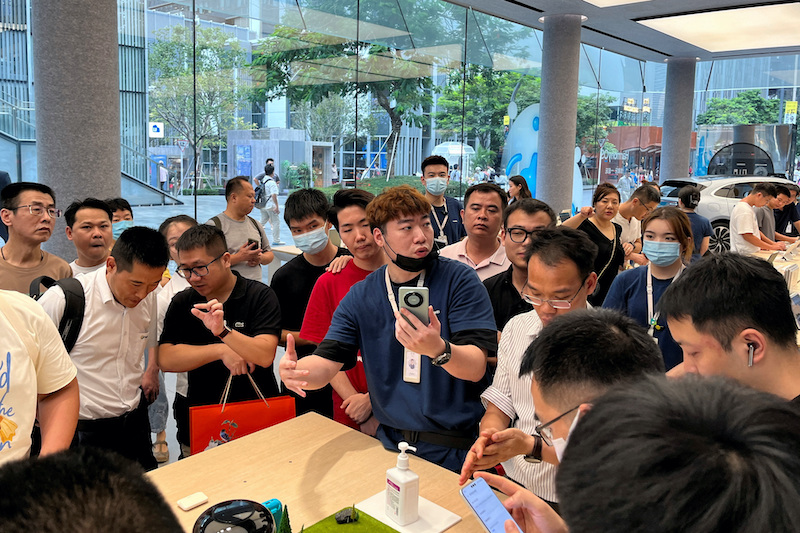The new 5G-enabled smartphone produced by Chinese technology giant Huawei Technologies is made with nearly 50% more homegrown chip components than any of its previous phones, research firm TechInsights has found.
“It looks like more than half, maybe two-thirds of the silicon is domestically grown capability, where in the phones we were seeing 2-3 years ago, a third was domestic. That’s another really big advance they’ve made,” Dan Hutcheson, an analyst with TechInsights said.
TechInsights, is currently in the process of taking the device — dubbed Huawei Mate 60 Pro apart — and previously discovered the phone was using a new 7-nanometre (nm) chip developed by state-backed chipmaker SMIC.
Also on AF: Apple and Tech Suppliers Hit by China’s Widening iPhone Curbs
“The significance is that it shows that China has been able to stay 2-2.5 nodes behind the world’s best (chip) companies. People thought they would be stopped at 14 nanometre,” Hutcheson said.
Both Huawei and SMIC have been the target of Washington’s sanctions, aimed to slow down their technological progress, and in-effect, China’s semiconductor and military capabilities.
Cost no bar
Analysts have been speculating on how costly it has been for Huawei to achieve the ‘breakthrough phone’, launched last week during US Commerce Secretary Gina Raimondo’s visit to China.
Some have raised concerns over what the chip’s production yield could be, which refers to the number of usable chips from each wafer and affects production costs.
Some research firms forecast SMIC’s 7nm process has a yield rate below 50%, versus the industry norm of 90% or more. Such low yield would limit shipments to around 2-4 million chips, not enough for Huawei to regain its former smartphone market dominance.
Hutcheson, however, said “above 50%” was reasonable in his view, saying the chip was made in a far cleaner fashion and was much more competent than an earlier iteration of a 7nm chip also made by SMIC that TechInsights examined last year.
“You can tell by how well it’s made,” he said. “China’s been buying tools like crazy so they probably have the capability to do this and yield ok with it.”
Better tech than ‘most phones’
Huawei’s smartphone business was decimated after the US started restricting tech exports to the company in 2019 and analysts say the phone could mark a first step in the company’s efforts to come back to rival Apple.
The phone’s launch sent Chinese social media users and state media into a frenzy, with buyers in China posting their own teardown videos of the phone.
Many shared speed tests on social media that suggest the Mate 60 Pro is capable of download speeds exceeding those of top- line 5G phones.
Users are also widely sharing videos to show the phone’s technological capabilities. One video purportedly showed the phone not only working underwater but even identifying ‘swiping’ gestures while being immersed.
Other users posted videos showing the phone’s camera and zooming-in capabilities.
I know Huawei Mate 60 Pro is good, I didn’t know it is so good! pic.twitter.com/emMJTZcKfk
— ❌️ (@MotulX22) September 3, 2023
The zoom-lens of Huawei Mate 60 Pro pic.twitter.com/AQHXAHUmWd
— 王淑婉 ♡🇨🇳♡🇮🇩♡🇨🇭 Speaks🇩🇪🇪🇸🇫🇷🇺🇸 (@we_ivy_) September 7, 2023
SK Hynix facing heat
Some early users of the phone have also posted videos of the phone containing NAND flash memory chips made by South Korea’s SK Hynix, which voluntarily suspended chip sales to Huawei after the Chinese firm was hit by Washington’s sanctions.
“SK Hynix no longer does business with Huawei since the introduction of the US restrictions against the company and with regard to the issue we started an investigation to find out more details,” the company said in a statement.
“SK Hynix is strictly abiding by the US government’s export restrictions.”
Shares of the chipmaker closed down more than 4% on Friday, after recovering from much steeper losses in earlier trade, over worries about US scrutiny resulting from its chip being found in the Mate 60 Pro.
- Reuters, with additional inputs from Vishakha Saxena
Also read:
Key US Lawmaker Wants End to Chip Exports to Huawei, SMIC
China Tells State Officials to Stop Using iPhones at Work: WSJ
Huawei’s Chip Breakthrough ‘May Spur Tougher US Tech Curbs’
New Huawei Phone Spurs Fear China Got Around US Chip Curbs























